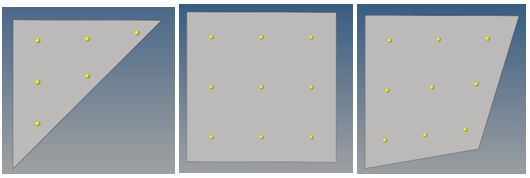hm_getaxisymmetricvolumereduced
Calculates the reduced volume of axisymmetric solids.
Syntax
hm_getaxisymmetricvolumereduced solids=<mark_id> elems=<mark_id> rotal_axis={<value>} reference_point={<value>} ?option=<value>?
Type
HyperMesh Tcl Query Command
Description
Calculates the reduced volume of the axisymmetric solids. The enclosed volume when the selected elements are fully rotated is considered to produce the full axisymmetric volume, with axis of symmetry passing through the defined by the reference_point with a direction defined by the rotal_axis option. The command outputs the volume formed by rotation of each element in the specified mark and the reduced volume for that element and the total result for all selected elements.
If an input element is outwards to the cross section of the selected axisymmetric solids along the direction perpendicular to the axis of rotation, it will also be considered as inside the solid unless it intersects with one of the selected solids.Inputs
- solids=<mark_id>
- The ID of the mark containing all the solids. Valid values are 1 and 2.
- elems=<mark_id>
- The ID of the mark containing elements which form the unreduced volume when rotated around the axis of symmetry provided. Valid values are 1 and 2.
- rotal_axis={valuex valuey valuez}
- The components of the vector defining the axis of symmetry for selected solids.
- reference_point={valuex valuey valuez}
- The coordinates of a point the axis of symmetry passes through.
- num_samples=<value>
- The number of samples used for analysis per each edge of quad and the maximum number
of samples per each edge of tria element. This is an optional argument. By default, one
sample is used per each element. Each sample point is chosen inside the element. The
figure below shows the sample points for num_samples set to 3.
Figure 1. 
- result_per_elem=<value>
- The optional flag controlling printing of the results. Valid values are 0 and 1 (default). By default, results for all elements are printed separately along with the total result at the end as described in the output. If set to 0, only the total axisymmetric unreduced volume and the total volume reduced are printed to command line.
Examples
For an axisymmetric surface in component “cross-section”, and vector of ID “1” as axis of symmetry, to find the reduced volume of displayed solids with rotal_axis vector (0,0,1) and passing through (0,0,0):
*createmark solids 1 "displayed"
*createmark elems 2 "cross_section"
hm_getaxisymmetricvolumereduced elems=2 solids=1 rotal_axis={0 0 1} reference_point={0 0 0}To find volume reduced in solids of IDs 5 and 6, with rotal_axis vector (0,0,1)(in other words, z axis as axis of symmetry) and passing through (-12.5,0,0) and taking 4 samples per each edge of an elem and result for individual elems suppressed:
*createmark solids 1 "id" 5 6
*createmark elems 2 "cross_section"
hm_getaxisymmetricvolumereduced elems=2 solids=1 rotal_axis={0 0 1} reference_point={-12.5 0 0} num_samples=4 result_per_elem=0Errors
if { [ catch {command_name...} ] } {
# Handle error
}Version History
2022.1